#valois dynasty
Explore tagged Tumblr posts
Text

Duke Philip "the Good" (1396-1467) of Burgundy
Artist: Rogier van der Weyden (Netherlandish, 1399 or 1400-1464)
Date: 15th century
Object: Painting
Collection: Kunsthistorisches Museum Vienna, Austria
Phillip the Good
Philip III the Good (31 July 1396 – 15 June 1467) ruled as Duke of Burgundy from 1419 until his death in 1467. He was a member of a cadet line of the Valois dynasty, to which all 15th-century kings of France belonged. During his reign, the Burgundian State reached the apex of its prosperity and prestige, and became a leading centre of the arts.
Duke Philip has a reputation for his administrative reforms, for his patronage of Flemish artists (such as Jan van Eyck) and of Franco-Flemish composers (such as Gilles Binchois), and for the 1430 seizure of Joan of Arc, whom Philip ransomed to the English after his soldiers captured her, resulting in her trial and eventual execution. In political affairs, he alternated between alliances with the English and with the French in an attempt to improve his dynasty's powerbase. Additionally, as ruler of Flanders, Brabant, Limburg, Artois, Hainaut, Holland, Luxembourg, Zeeland, Friesland and Namur, he played an important role in the history of the Low Countries.
He married three times and had three legitimate sons, all from his third marriage; only one legitimate son reached adulthood. Philip had 24 documented mistresses and fathered at least 18 illegitimate children.
#portrait#duke philip the good#duke of burgundy#french history#valois dynasty#burgundian state#painting#oil painting#costume#hat#document#rogier van der weyden#netherlandish painter#netherlandish art#fine art#french nobility#15th century painting#european art#artwork
19 notes
·
View notes
Text
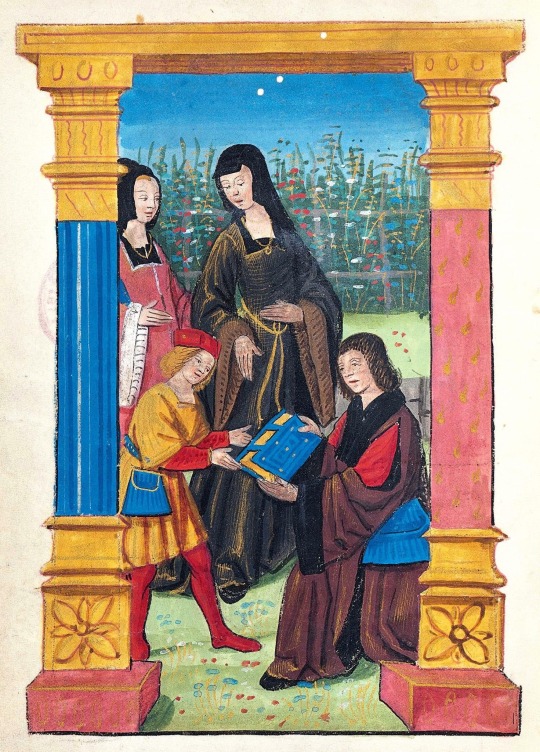
François I received a book in the presence of his mother, Louise de Savoy, and sister, Marguerite d’Angoulême.
Date: 1503.
Source: National Library of France
Description taken from here:*
“Master of Philippe de Gueldre, "Antoine Vérard presents his book to François d'Angouleme, in the presence of Louise de Savoie and Marguerite d'Angoulême, in Octavien de Saint-Gelais, Le Séjour d'honneur, Paris, Antoine Vérart
BnF, Rare Book Reserve, Venom 2239, fol. 1st
In 1506, after his engagement to Claude de France, daughter of Louis XII, François d’Angouleme is summoned to court as heir to the throne. It is no doubt on this occasion that the Parisian bookwire Antoine Vérard is preparing for him a personalized copy of his edition of the Séjour d'Honneur, allegory describing the court of Charles VIII. In the light of dedication, the young prince receives the volume of Vérard's hands, under the gaze of his mother, Louise de Savoie, and a young girl who is undoubtedly his sister, Marguerite.”
*facebook group entitled “enluminures Europe—VIe -XVIe s.”
#16th century France#16th century#XVIe siècle#enluminures#Valois-Angoulême dynasty#Valois dynasty#House of Valois#House of Valois-Angoulême#Maison de Valois#Maison de Valois-Angoulême#Louise de Savoyie#Louise of Savoy#marguerite de navarre#Marguerite d’Angouleme#François Ier#François I#Francis I of France#François de France#primary sources#illuminated manuscript#Louis XII#claude de france
12 notes
·
View notes
Text

Coronation of Philippe VI, the first of the House of Valois to rule France.
#manuscript#Middle Ages#medieval France#medieval#house of Valois#valois dynasty#Maison de Valois#Philippe VI#Philippe VIème
9 notes
·
View notes
Text

#house of lancaster#house of Navarre#house of Brittany#Joan of Navarre#Queen Joan#Joanna of Navarre#Queen Joanna#Jehanne d’Évreux#Plantagenet dynasty#Valois dynasty#house of valois#maison des valois#Henry IV#John V#Lancastrian edit#Lancastrian consort#queen of England#medieval England#naomi watts#Jodi comer
16 notes
·
View notes
Text
Second of the two books wrapped up today:
The Thirty Years War and the Eighty Years War were matched by both the War of the Three Kingdoms, the Time of Troubles, and ultimately these wars. In the course of the Protestant Reformation the blend of state and church power espoused in two mirrors by the Catholic Church and Catholic communities and by Protestants, especially the Calvinists who fought on the Protestant side in France, ensured a bloody couple of centuries that paved the way for de facto tolerance from exhaustion and the none too subtle horrors of the time beforehand. There were a total of eight major Wars of Religion culminating in the first case with Henry IV and the War of the Three Henries, and then in this book's case extended to the 1620s and the fighting with the Huegenots that would contribute to the revocation of the Edict of Nantes.
One rather grim irony here is that the book references the ideas of Protestants as traitors fomenting discord as a stereotype and then notes repeatedly that the Protestants did exactly foment discord and ultimately the idea of kidnapping and indoctrinating the King in much the way the Kirk tried to do with Charles II and ultimately failed. It also notes that however strong the French state up to the outbreak of the wars that it was too weak to resist a scattered and deeply divided set of Huegenot movements in the towns, meaning that most of the wars saw a period of sporadic and brutal fighting across the same regions that amplified bloodshed and the tempers of both sides without actually resolving the wars.
Most pointedly this is one of the few authors covering a religious war who grants that religion in fact is the cause of religious wars instead of doing the more fashionable 'sure they said it was and it was a conflict of rival sects who openly boasted that it was a difference of religious opinion but it totally wasn't religion. Source: Dude Trust me Trust me bro it's not that we only believe in ideological motivations when it's communist peasants bro'.
8/10.
#lightdancer comments on history#book reviews#valois dynasty#french wars of religion#bourbon dynasty
0 notes
Text
Headcanon on absolutely no evidence: Violetta is Tarvek's half-sister on "the wrong side of the blanket".
This doesn't put her in the line of succession for the Lightning Crown, because we know Tarvek traces his line of descent through his mother, who has been otherwise mentioned ONCE, in extra dialogue in the second novel. I strongly suspect she died when Tarvek was very young, having successfully produced a male heir and an elder "spare", and that there was no love lost between her and Wilhelm. Not that I'm pointing fingers for murder here. (points fingers) Is it unlikely that Wilhelm Sturmvoraus went off after she died (or before) and had himself an illegitimate kid elsewhere? Just because he could, or because sometimes biology happens? No, it is not.
Tarvek doesn't officially know this, but then he tries very hard to not officially know this. Not even secretly officially. He doesn't know. He doesn't want to know. He isn't asking and would take steps to make sure no one else asked, either. Nobody is allowed to ask this question. If he knows, other people could know. If other people know, Violetta is in more danger than ever before, because that one Smoke Knight, an ambiguously-defined "cousin", who publicly and definitely doesn't like him, is one thing. A sister is a TARGET.
We know Tarvek has a very short list of people he genuinely cares about and can't handle losing, and we know Violetta is on it. Violetta is not allowed to be in more danger than she already is.
(Violetta does not know this, does not suspect, and would be furious if she found out.)
#girl genius#headcanon#tarvek sturmvoraus#violetta mondarev#valois dynasty nonsense#“cousin” is such an easy euphemism
24 notes
·
View notes
Text

Charles VII, King of France.
#royaume de france#maison de valois#charles vii#le Victorieux#le Bien Servi#roi de france#vive le roi#dynastie des valois#comte de ponthieu#kingdom of france#house of valois#king of france#full length portrait#guerre de cent ans#hundred years' war#full-length portrait#hundred years war#french school
5 notes
·
View notes
Photo

29 mai 1328 : avènement de la branche de Valois à la couronne de France ➽ http://bit.ly/Avenement-Valois À la fin de l’année 1327, le roi Charles IV, que sa beauté et sa vigueur avait fait surnommer le Bel, comme son père, avait été la proie d’une maladie grave et rendu l’âme le 1er février 1328 dans le château de Vincennes, où il faisait sa résidence, « laissant veuve et enceinte la reine sa femme, plongée dans la désolation »
#Cejourlà#29mai#avènement#branche#royale#dynastie#rois#Valois#PhilippeVI#Capétiens#CharlesIV#royaume#France#politique#histoire#france#history#passé#past#français#french#news#événement#newsfromthepast
13 notes
·
View notes
Text
Desperately looking for books about-
• Marguerite de Valois that aren’t riddled with gossip/myths (as the primary source of information). Each time I try to google recommendations I’m given Dumas’s book.
• Fulvia
• Members of the Julio Claudian Dynasty. I don’t have a preference in terms of who it focuses on but I tend to gravitate towards books that discuss one individual at a time. (especially any books good for beginners)
#Marguerite de Valois#french history#catherine de medici#history#ancient history#history tag#julio claudian dynasty#fulvia#roman history
2 notes
·
View notes
Text
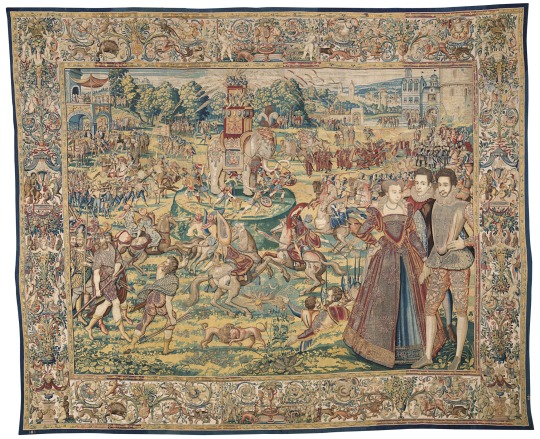
Elephant, circa 1576

detail: Francis, Duke of Anjou, Margaret of Valois, Henry II, Duke of Lorraine
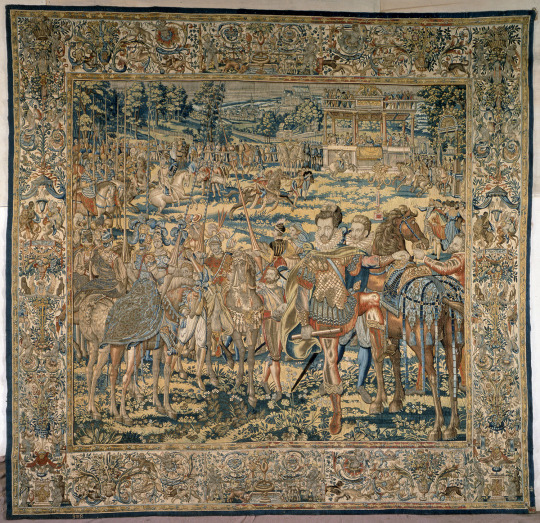
Quintain, circa 1576, Henry III in the foreground
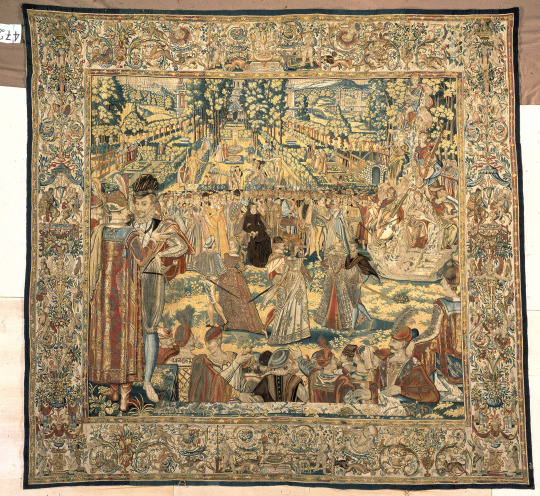
Polish Ambassadors, circa 1576

Tournament, circa 1576

Barriers, circa 1576

Journey, circa 1576

Fontainebleau, circa 1580, Henry III and Queen Louise of Lorraine in the foreground

Water Festival at Bayonne, circa 1580-81, depicts festivities at the summit meeting between the French and Spanish courts at Bayonne in 1565
The Valois Tapestries
“The series is composed of eight tapestries, woven with wool, silk, silver and gilt metal-wrapped thread, commissioned around 1575 by Catherine de’ Medici to an unidentified Brussels atelier, based on cartoons by Lucas de Heere from drawings by court painter Antoine Caron.” (x)
The tapestries are in the Uffizi Museum in Florence (x)
#history#history of france#catherine de' medici#the valois dynasty#henry iii of france#art#tapestries
45 notes
·
View notes
Text
Oh that is wonderful.
I was mostly entertaining the thought as an excuse to come up with OCs as well, but I kept wondering what the end result would actually look like and how it'd manifest.
Like would the kids have a merged sort of hair colour, signifying a smooth blend of genetics, or would it be very distinct actual chimerism where you'd get differing DNA profiles depending on which part of the person you sampled?
It's SCIENCE! so you could probably end up with either!
I had a silly thought.
One day in the future, once everything has settled and been dealt with (or as settled and dealt with as it ever could be in Europa), Agatha will likely have children to continue the Heterodyne line.
But in order to ensure a sense of balance and equality between her paramours, she uses SCIENCE! to influence the child's genetics, so that it's a mix of hers, Gil's and Tarvek's, possibly in a distinct form of Chimerism or just some weird mix.
And then my thoughts got derailed on what the 'appropriate' mix of genetics would be - should it be equal? Should Agatha's take precedence and be a full 50% and the remainder split between Tarvek and Gil?
Also did any other Heterodynes ever do weird shit like that to their kids? It doesn't seem like it.
#klaus is just horrified his progeny is sharing genetics with the valois regardless of how#the idea that a future baron of the wulfenbach empire would be even in part a valois gives him almost as much of a conniption as the fact#that the blood of lucrezia 'The Other' mongfish will as well#it's a dynasty that nobody in europa is actually happy to see mixed!#a combination of FOUR of possibly the most hated bloodlines by different people!#some will hate wulfenbach others hate the valois#everyone's afraid of the heterodyne and the less said about lucrezia the better
80 notes
·
View notes
Text

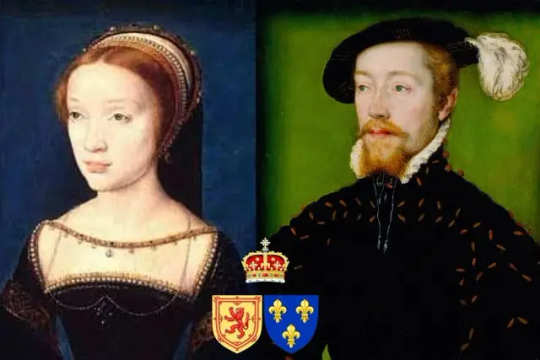
James V, King of Scots married Madeleine de Valois on January 1st 1537.
Madeleine of Valois was a French Princess who played a brief but significant role in European history as the first wife of James V of Scotland and, for a short time, the Queen of Scotland.
Madeleine’s poor health meant she died only six months after their wedding day – her short time as Consort led her to receive the nickname the ‘Summer Queen’ of Scots. Despite her short reign and tragically young death, Madeleine left both a direct and indirectly lasting impact on the tumultuous political landscape of Scotland.
Madeleine of Valois was the fifth child and third daughter of King Francis I and Claude, Duchess of Brittany.
She was born at the Château de Saint-Germain-en-Laye in France on 10 August 1520. Frail since birth, Madeleine was raised in the mild climate of the Loire Valley region to protect her from the cold.
When Madeleine was 3 years old, her mother died, and she, along with her younger sister Marguerite, was raised by their paternal aunt, Marguerite of Navarre. However, after their father remarried Eleanor of Austria, Madeleine became part of her household.
By the age of 16, Madeleine had developed tuberculosis, the same illness that likely claimed her mother’s life.
Madeleine’s marriage to James V was a result of diplomatic alliances between the Valois and Stuart dynasties.
The Treaty of Rouen, signed three years before Madeleine’s birth, aimed to strengthen the ‘Auld Alliance’ between France and Scotland after Scotland’s shattering defeat by England at the Battle of Flodden. One provision of the treaty was the marriage of a French princess to the Scottish king. King James V was only 5 years old at the time of the Treaty, thus negotiations on the marriage did not begin until 1530.
In April 1530, John Stewart, Duke of Albany, was appointed commissioner to finalise the royal marriage between James V and Madeleine – the French King Francis I’s eldest living daughter. However, due to Madeleine’s poor health, Francis proposed an alternative French bride, Mary of Bourbon, from his extended family, who was to be given a dowry as if she were the French king’s daughter.
James V agreed to marry Mary, and travelled to France in 1536 to meet her. However, upon his arrival, Mary didn’t appeal to him and instead he became enamoured with Madeleine, promptly asking her father Francis I for her hand in marriage. Initially, Francis I refused, fearing that Scotland’s climate would worsen Madeleine’s fragile health.
Smitten by 16 year old Madeleine’s delicate beauty, James V continued to press Francis I to permit the marriage. Madeleine also made her desire to marry James very obvious, thus despite his reservations, Francis I reluctantly granted them permission. The marriage contract was made at Blois, where Madeleine renounced her claims to the French throne, and Francis I provided a substantial dowry.
James V and Madeleine were married on 1 January 1537 at Notre Dane Cathedral in Paris – Madeleine was 16 and James was 30. The union was celebrated with four months of festivities, strengthening the bond between France and Scotland and fulfilling the terms of the Treaty of Rouen. Due to Madeleine’s health, their journey to Scotland was delayed until spring.
James and Madeleine eventually sailed for Scotland, arriving on 19 May 1537, yet by this time, Madeleine’s health had deteriorated further, and she was very unwell when the royal couple landed at Leith. Despite this, Madeleine is said to have kissed the ground upon arriving in her husband’s kingdom.
In preparation for her arrival, James had ordered improvements to Falkland Palace and the Chapel Royal, and was also in the process of building new tennis courts, and had added a French-style tower to the Palace of Holyrood House.
However, Madeleine fell seriously ill shortly after arriving in Scotland, possibly due to tuberculosis. She was bedridden and unable to fullfill her role as queen consort. Despite her illness, Madeleine’s presence brought a touch of French culture and refinement – known for her beauty, grace, and intelligence, Madeleine quickly became beloved by the Scottish court.
Although expressing some improvement in a letter to her father from Edinburgh on 8 June 1537, James V was concerned enough to also write to him requesting the physician Master Francisco to be sent. Madeleine later wrote that Francisco would only be needed to perfect her cure.
Plans were underway for Madeleine’s coronation as Queen of Scotland, yet her health continued to decline. A month later, she died of tuberculosis in her husband’s arms on 7 July 1537 at Holyrood Palace, aged 16 – just 6 months and 7 days after their wedding. She was interred in the Royal Chapel at Holyrood Abbey in Edinburgh, next to King James II of Scotland.
Her death left James V devastated, and plunged Scotland into mourning.
20 notes
·
View notes
Photo

Edward III, King of England, paying homage to Philippe VI, King of France.
#edward iii#plantagenet dynasty#philippe vi#maison de valois#valois dynasty#middle ages#suseran#vassal
6 notes
·
View notes
Note
Hi, I really like your theories about undertaker. I am looking forward to new one!!!😭 but I have some random questions: what do you think about Undertaker’s human life? Was he a French (Breton) aristocracy, was he connected to French royalty and so on. Also, did Undertaker first work in French grim reaper department, does he hate British aristocracy? I will be very thankful for your answer
Hi, thank you so much for your ask :) I researched this stuff before starting this blog anyways, but it makes me very happy to see people enjoying my theories! Or even just reading them - I know they're a little bit on the crazy side in terms of detail and length 😅
Short answer - PTSD fuel, yes, yes, yes, no (mostly) 😄
Longer answer (+ discussion of theories to come) below the cut
What do you think about Undertaker's human life?
PTSD fuel man. PTSD fuel. War, Civil War, Plague, Mental Illness. Being born into privilege did not shield him from any of this.
I think he was close with his mom due to links I believe Yana has made to certain historical figures - though I would not be surprised if, keeping with the trend, she died when Undertaker was 15 in 1346. This is the same age that Vincent was when Claudia died.
Was he a French (Breton) aristocracy, was he connected to French royalty and so on.
Yes, I do think Undertaker is related by blood to the Dukes of Brittany and to the French Monarchy (honestly there are so many inter-marriages that saying one is also saying the other). I place particular importance on his connection with both the House of Capet, who ruled in France from 987 to 1328, and their direct descendants, the House of Valois, whose 13 kings ruled in France from 1328 (3 years before what I believe to be his birth year, 1331) to 1589 (3 centuries before the current setting of the manga, 1889).
I believe Kuroshitsuji and Undertaker's past was influenced by a series of historical fiction called The Accursed Kings which takes place in 14th century France (I haven't seen the Accursed Kings as inspiration discussed before). George R.R. Martin, author of A Song of Ice and Fire (Game of Thrones) has also cited these as an inspiration for his series. (I learned everything I know about tinfoil from the ASOIAF subreddit, iykyk). When I saw that George had used these books as inspiration as well I found it hilarious because I've always said that Yana Toboso's level of plotting and lore is on the same level as George R.R. Martin's, and that she doesn't get nearly enough credit for it - at least, not in the western world.
I think the hair within Undertaker's ring might belong to the Capetien King Louis IX, which would make the ring a reliquary as Louis IX was the only French King to be canonized as a saint (he is the patron saint of the French monarchy). I discussed reliquaries in my Rossignol theory post - and I will continue to discuss them in more detail in my future posts. The Capetien dynasty is definitely relevant, but given they're related to 75% of European nobility, it's a ton of names and dates for me to try and keep straight.
Those houses aren't the only ones; I think Yana has woven in references to the first king of the Franks, Clovis I, and his wife, Clotilde (patron saint of the lame 👀 i am excited to talk about this woman as an inspiration for Claudia's name!), as well as the emperor Charlemagne, as well the many houses that descended from the Capetians (I believe one house that ruled in Brittany relates back to a certain Viscount, which explains why Undertaker is protective of the bastard...).
Well, as I said, it's a lot of details to sort through!
Did Undertaker first work in the French grim reaper department?
Yes, I agree with that theory, but I don't have much to add to it at the moment. As I said, I think that he reaped King Louis XV's soul explains how he ended up with the Hirsch Aquamarine - I would imagine he's reaped many a French monarch's soul between 1366 and 1819.
Does Undertaker hate the British aristocracy?
Well... It's complicated; Undertaker is one complicated cat. But no, I don't think Undertaker hates the British aristocracy.
Now admittedly, he probably wasn't too fond of the British people as a whole after having been at war with them his entire life. I believe Undertaker was born March 25, 1331 and died at age 34 on January 28, 1366. The Hundred Years War between France and England broke out in 1337, when he was 6. The Breton War of Succession began in 1341 when Undertaker was 10, and this was in itself a proxy war between France and England. France backed the female claimant to the Duchy of Brittany of the House of Blois, and England backed the male claimant of the House of Montfort.
But not being fond of the British people or British aristocrats does not equate to hating them - and then, of course, he met Claudia. I really believe he is (in his own mind, at least) devoted to Claudia and her memory, and to the last remaining Phantomhive. Of course, she'd probably be rolling in her grave if she knew the wacky shit he's been up to in her absence.
Anyways - ultimately I think the sin that Undertaker finds most despicable is greed, especially when it's at the expense of your own people. He isn't prejudiced against a particular group of people, but all who embody this sin.

Anti-capitalist king 👑
This goes back to a lot of things; my theory about "Holy Monday", Jesus Christ, the novel Ivanhoe, the novels of The Accursed Kings, the Knights Templar, King Philip IV, King Louis IX, The Irish Potato Famine, even The Tower Bridge. I think it would make a lot of sense for Undertaker to despise greed given he blames it for the horrors of his past. And I believe there are hints in the manga that for all their less savoury aspects, Claudia, Vincent, and O!Ciel are not greedy in the way Undertaker finds distasteful... but R!Ciel might be.
Thanks again for reading 🥰 and thank you for the ask!
#ask#i hope you don't mind me publishing this!#undertaker theory#kinda#black butler#kuroshitsuji#anti-capitalist king#i've called him that as a joke for a while but now it's actually kinda serious lmao#undertaker
18 notes
·
View notes
Text
The first of two intertwined books I finished today:
One of two relatively short books I read today, both building on a continuous narrative of French history starting in the immediate aftermath of the end of the Hundred Years War to just before the outbreak of the Wars of Religion. The basic gist of it is that in 295 pages of social history this book argues that France took steps to become a nation-state, even when this was not a direct intent of those who ruled France in this time, and that these steps ultimately contributed to the Wars of Religion and to the backlash against the growth of royal power that it ultimately argues was a key part of said Wars.
This book in turn by comparison to the book on the Capetians notes that the growth of royal power and autocratic power in France was very real, that it was a consistently focused project including the deliberate tailoring of propaganda to the circumstances, and that the ultimate success here both revolutionized France and the French elites.
0 notes
Text
Headcanon to no particular purpose:
Mechanicsburg loves its visual, musical, and performance arts about as much as it loves its explosions and monsters and mayhem (the former often involves the latter anyway).
IN THE FUTURE, Agatha makes it known that she is happy to commission new works for the entertainment of her people (monsters and all) - on one condition:
it may not involve her family in any way.
She is...nonspecific about exactly who this includes.
Her immediate family, of course. No half-disguised Triumvirate romance operas will be tolerated in Mechanicsburg, and certainly not paid for by the Lady.
THE family, almost certainly. No historical stage retrospectives about the Heterodynes (Mechanicsburg has their own).
But...where does it stop? Can they put on dramas about fictional characters during recent history? What if they don't mention the Wulfenbach Empire specifically? What about the Queens of Skifander? How many degrees removed from Tarvek do you have to get before you can mention the Valois dynasty - or any of the Fifty Families they're related to...which is all of them? Is this artist really really really sure their subject wasn't involved with the Heterodynes in some way?
...Agatha is also nonspecific about what the consequences will be, and is kind of looking forward to finding out.
Mechanicsburg becomes the place to be for sci-fi and fantasy.
Paris gets all the historical shows and political farces, and tends to be the first stop for performers traveling from elsewhere in the World.
(Elsewhere, Heterodyne shows like Master Payne's circus are still going strong and writing new plays as fast as they can keep up. But it's understood that bringing them to Mechanicsburg isn't worth the audience, which will stand up and argue with the actors in real time in defense of their Lady, her consorts, and the rest of her family.)
#girl genius#headcanons#mechanicsburg#i put words on the screen to get them out of my head#futurefic headcanons#agatha heterodyne#ot3#the heterodyne family#tarvek sturmvoraus#gilgamesh wulfenbach
291 notes
·
View notes